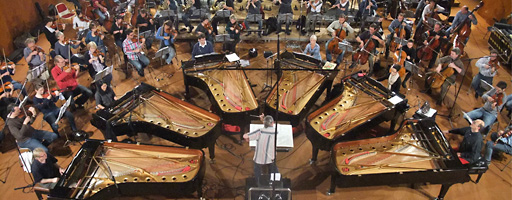Two pieces on the final, orchestral concert at the 2010 Donaueschinger Musiktage, though very different from one another, brought up powerful images of landscapes, geographies, topologies. In fact, I can’t think of another musical experience that’s done that more powerfully than either one of these pieces. I might call that great programming. But it could not have been deliberate. Both of these pieces were world premieres. No one, including the composers themselves, could have known just what these pieces would be at the time they were programmed.
James Saunders wrote in the program notes that “‘Geometria situs’ is the Latin term adopted for the study of the geometry of place. This field of mathematics has become known as topology.” At the time I heard the piece live, I had only read the program notes in their German translation, and this point was lost on me. I heard an almost perpetually flickering, unstable quality, a play at the edges but not at the center of each sound. I had the mental image of the sounding body of the orchestra supporting, but not appearing within, what was heard. The clearest analogy might be an aerial view. There are obscuring elements (clouds) and so much detail that it cannot all be taken in. One thing is covered by another, either wholly or partially. And there are many things, both seen and unseen (heard and unheard). A crucial question for me is often, what parameters are at play in a piece? I wrote at the time that it was bold and skilled to make it not about pitch or rhythm, and barely about timbre or texture. Pitch was frequently static, and otherwise moved very slowly. There was little overt rhythmic action. Timbre was always flickering, always changing, but in such detail, instrument by instrument, that it was not a structural element. To my ear, the two related parameters at play were the degree of shallowness or depth of the sounding body and the solidness or instability of its component parts. Going back to the aerial view image, how deep into the surface can be seen, and how high does it project? Whatever is nearest to the eye or lens takes precedence, and will at least partially obscure what is below it. It is an inversion of the way things appear at ground level, and lightens the cumulative perceived weight. Anything in motion will attract the ear, as it does the eye. Each player had pages not only for their own primary instrument, but for related auxiliary instruments–blown tubes, bowed materials, etc. Each instrument, whether primary or auxiliary, alternated between transitional passages and sustained sounds.
So if that’s a listener’s perspective (or at least this one listener’s perspective), I had little to no idea of the players’ positions in relation to this sound world until I had a chance to see the score. Saunders wrote that he “wanted to create a situation where players had some autonomy, and in particular where choices they make have an effect on the shape of the piece.” They are given a set of pages, and individually choose the order of those pages before the start of the piece. They also choose at which cue to enter on each new page. The conductor controls the flow of time, according to the selection of one of five time charts. The title refers to “the spatial properties of an object that remain constant when undergoing deformations such as compression or stretching, but not by cutting or gluing.” The local details of the score and the total duration are more or less constant, but the sequence and flow in time is distorted, and will never be the same from one performance to another. The sounding world of the piece is established by the details within the score, but the players actively shape the spacing and sequence of those actions.
Hearing Ivan Wyschnegradsky‘s Arc-en-ciel and Arc-en-ciel II was an ear-opening experience for me. The six pianos each have a separate tuning, so that each whole-tone is evenly divided into twelfth-tones. (For any non-musicians who might be reading, in a nutshell there are five new, evenly-spaced notes between each note on a regularly-tuned piano. Each pianist takes a separate increment of that subdivision.) I have tended to experience microtonal inflections as a kind of color. At times I would mentally discount for that, thinking that a singer or wind player brought in a new element to the sound because it was something other than the usual tuning. (I don’t think that logic holds up, but I don’t recall closely reasoning with myself at the time.) These pieces delved into and sustained a palette of sonic colors I had never before imagined, opening up a whole new landscape.

Georg Friedrich Haas dove into the space opened up by Wyschnegradsky’s work and found a broader view with limited approximations. I know many people were very moved by this piece. I think it has something to do with being taken to a new place, the experience of these fresh vistas and colors. Neither Wyschnegradsky nor Haas cluttered the field, but gave the tunings room to sound in various combinations and configurations. In the Haas in particular, I related to it at many points as journeying to a new space, and then pausing to take it in. The operatic analogy might be that of recitative and aria. The program notes reference ‘an “aria” of overtones.’ Haas also speaks about moments of fusion and moments of friction. The detail of the tunings allows for a rich and specific network of overtones. It also allows for a very close rubbing between tones locally. The possibilities for both consonance and dissonance are expanded.
I’ve gained a lot by thinking and reading and listening back on these pieces. I had some strong impressions at the performance, but I didn’t fully know what it was that I was experiencing the first time. Truth be told, I still don’t.
